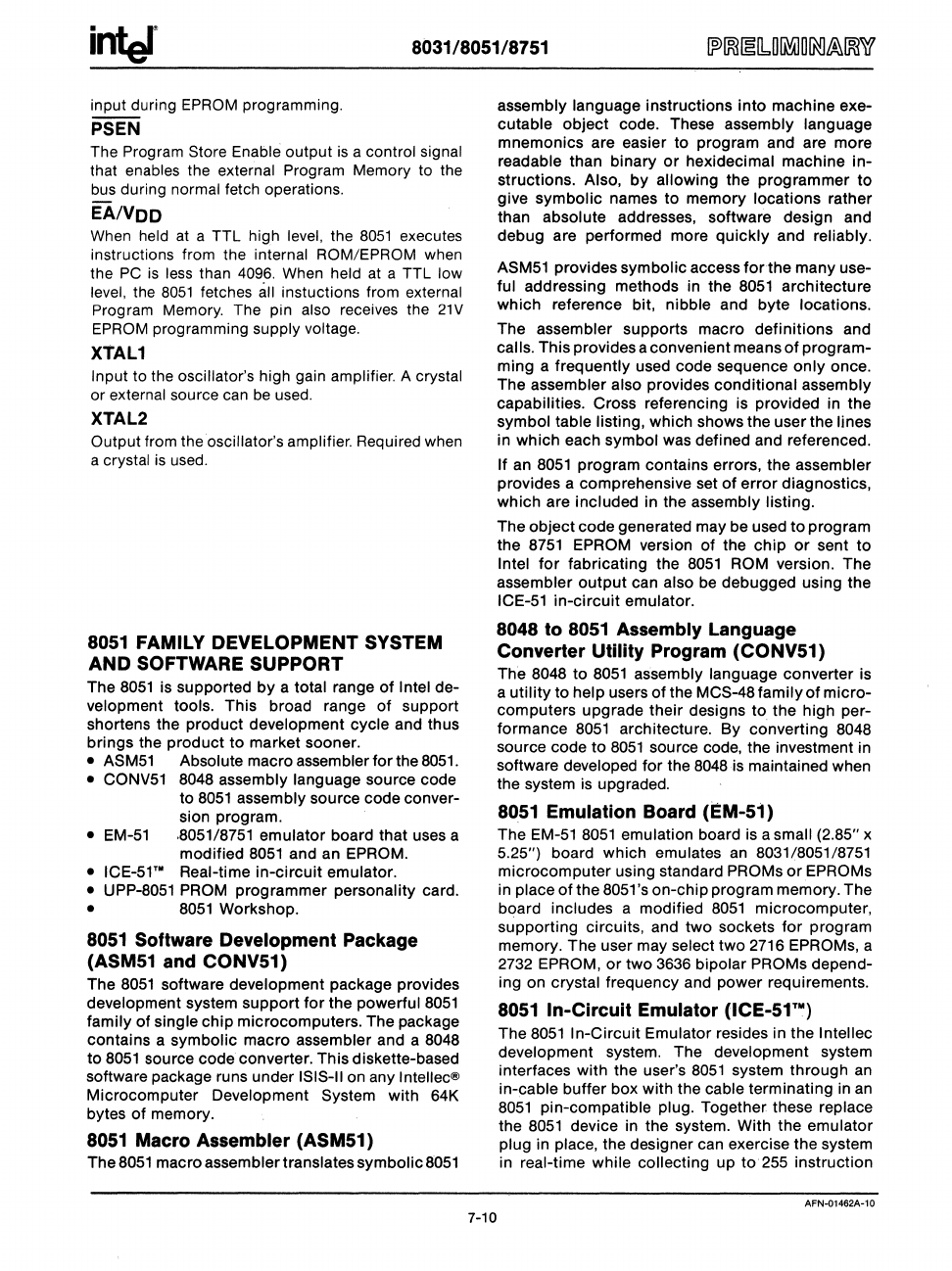
inter
8031/8051/8751
input during EPROM programming.
PSEN
The Program Store Enable output
is
a control signal
that enables the external Program Memory to the
bus during
normal fetch operations.
EAIVOO
When held
at
a TTL high level, the
8051
executes
instructions from the
internal ROM/EPROM when
the
PC
is
less than
4096.
When held at a TTL low
level,
the
8051
fetches all instuctions from external
Program Memory. The pin also receives the
21V
EPROM programming supply voltage.
XTAL1
Input to the oscillator's high gain amplifier. A crystal
or external source can
be
used.
XTAL2
Output from the oscillator's amplifier. Required when
a
crystal
is
used.
8051
FAMILY DEVELOPMENT SYSTEM
AND SOFTWARE SUPPORT
The
8051
is supported
by
a total range
of
Intel de-
velopment tools.
This
broad range of support
shortens the
product
development cycle and thus
brings the
product
to
market sooner.
• ASM51 Absolute macro assemblerfor the
8051.
• CONV51 8048 assembly language source code
to
8051
assembly source code conver-
sion program.
• EM-51
,8051/8751 emulator board that uses a
modified
8051
and an EPROM.
• ICE-51'· Real-time
in-circuit
emulator.
•
UPP-8051 PROM programmer personality card.
•
8051
Workshop.
8051
Software Development Package
(ASM51 and CONV51)
The
8051
software development package provides
development system
support
for
the powerful
8051
family
of single
chip
microcomputers. The package
contains a
symbolic
macro assembler and a 8048
to
8051
source code converter. This diskette-based
software package runs under
ISIS-II on any Intellec®
Microcomputer Development System with 64K
bytes
of
memory.
8051
Macro Assembler (ASM51)
The
8051
macro assembler translates symbolic
8051
7-10
assembly language instructions
into
machine exe-
cutable
object
code. These assembly language
mnemonics are easier to program and are more
readable than binary
or
hexidecimal machine
in-
structions. Also,
by
allowing the
programmer
to
give
symbolic
names
to
memory
locations rather
than
absolute addresses, software design and
debug are performed more
quickly
and reliably.
ASM51
provides symbolic access
forthe
many use-
ful addressing methods in the
8051
architecture
which reference bit,
nibble and byte locations.
The assembler supports macro
definitions
and
calls. This provides a convenient means
of
program-
ming a frequently used code sequence
only
once.
The
assembler also provides
conditional
assembly
capabilities.
Cross referencing is provided in the
symbol table listing, which shows the user the lines
in which each symbol was defined and referenced.
If an
8051
program contains errors, the assembler
provides a comprehensive set
of
error
diagnostics,
which
are included in the assembly listing.
The object code generated may be used
to
program
the
8751
EPROM version of the
chip
or
sent
to
Intel
for
fabricating the
8051
ROM version. The
assembler
output
can also be debugged using the
ICE-51
in-circuit
emulator.
8048
to
8051 Assembly Language
Converter Utility Program (CONV51)
The 8048
to
8051
assembly language converter is
a
utility
to help users
of
the MCS-48
family
of
micro-
computers upgrade their designs
to
the high per-
formance
8051
architecture.
By
converting 8048
source code
to
8051
source code, the investment in
software
developed
for
the 8048 is maintained when
the system
is
upgraded.
8051
Emulation Board (EM-51)
The EM-51
8051
emulation board
is
a small (2.85" x
5.25") board which emulates an 8031/8051/8751
microcomputer
using standard PROMs
or
EPROMs
in
place
of
the 8051's on-chip program memory. The
board
includes a modified
8051
microcomputer,
supporting circuits, and two sockets
for
program
memory. The user may
select
two
2716 EPROMs, a
2732 EPROM, or two 3636
bipolar PROMs depend-
ing on
crystal frequency and power requirements.
8051 In-Circuit Emulator (ICE-51™)
The
8051
In-Circuit
Emulator resides in the Intellec
development
system. The development system
interfaces with the user's
8051
system through an
in-cable buffer box with the cable terminating
in
an
8051
pin-compatible plug. Together these replace
the
8051
device
in
the system. With the emulator
plug
in place, the designer can exercise the system
in
real-time while collecting up
to
255 instruction
AFN-01462A-10


















